This was published 1 year ago
Big stink at the fish market as ‘greedy’ tenants drag out design stoush
A former fish market boss says the new billion-dollar taxpayer funded building is destined to become a white elephant: “You don’t need the Taj Mahal to flog dead fish.”
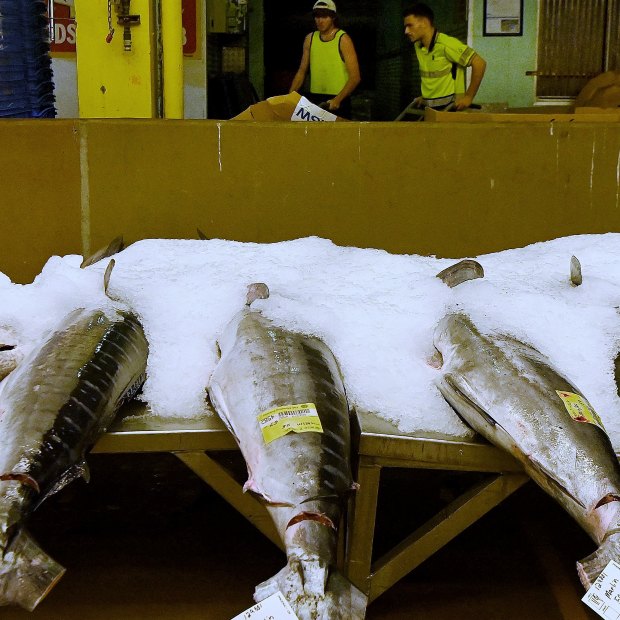
Marlin at the Sydney Fish Market, ahead of an auction this week.Credit: Kate Geraghty
A state-of-the-art building that will cost taxpayers nearly a billion dollars was handed to the Sydney Fish Market for the same peppercorn rent it is paying at its existing dilapidated site, in a sweetheart deal that has soured into a stoush over the final design.
The new market at Blackwattle Bay in Pyrmont is due to open by the end of the year, and the government is eager to advertise for expressions of interest to develop the old site, so construction can begin as soon as the existing tenants vacate.
But the retailers who sublease their shops and restaurants from the Sydney Fish Market claim the new building – which is being compared to the Sydney Opera House and is expected to double its 5.5 million annual visitors – will not meet the operational requirements of a fish market.
Former Sydney Fish Market chairman Grahame Turk said the building was destined to become a white elephant: “You don’t need the Taj Mahal to flog dead fish.”
Only one of the 38 subtenants has been prepared to surrender their existing lease and sign a new one for the premises under construction, raising concerns the hold-outs will seek compensation for being forced to vacate without a similar or better deal.
They argue that the fit-out allowances have not kept pace with rising costs. Critics have accused them of “greed”.
And in the midst of tense negotiations with the government for design changes that will satisfy the subtenants, the market boss has floated opening a second transport hub near the soon-to-open Western Sydney Airport to capitalise on the export opportunities to Asia.
“We could have beautiful quality Australian seafood out of the water and up to Singapore overnight, which would be quite remarkable,” Sydney Fish Market chief executive Greg Dyer said.
The market under construction, designed by Danish architects 3XN, will be twice the size of the existing site and as big as three Queen Victoria Buildings side-by-side.
‘It’s a wonderful building – beautiful building – but it can’t function as a fish market in its current design.’
Grahame Turk, former Sydney Fish Market boss
It sits under a wave-shaped, scale-patterned roof with a basement for parking, a temperature-controlled operations level for the daily auction and wholesale outlets, and a retail level at the top.
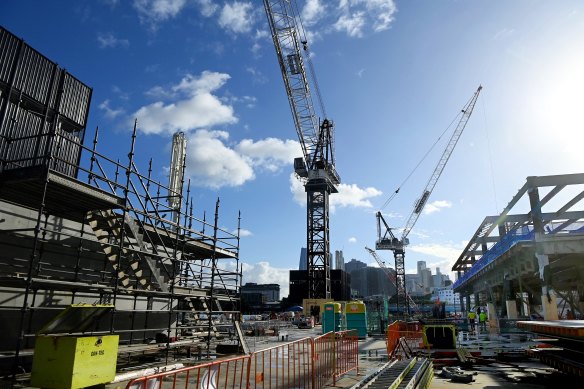
Construction workers at the site of the refurbished Sydney Fish Market.Credit: Kate Geraghty
The Herald can reveal the new agreement for lease between the Sydney Fish Market and the government grandfathered the rent at the current rate of $2.8 million per year for the first 10 years – about half the average commercial rent for Pyrmont by square metre, according to the latest quarterly report by real estate agent Cushman and Wakefield.
For a $750 million construction, this delivers a yield to the government of 0.4 per cent. Landlords can generally expect an annual yield of 5.5 per cent on a commercial property. Government sources not authorised to speak publicly have raised eyebrows at the return to taxpayers.
The government agreed to build the market on a separate site to ensure no interruption to trade during construction. While 27 new subtenants will be charged at the market rate, the existing tenants will pay their current rate.
The six seafood retailers also have the benefit of a long-standing, unwritten promise by management that no new fish shops will be accepted as tenants, which will extend to the new site.
NSW Lands and Property Minister Steve Kamper said the agreement for lease was signed by the former government and his government was required to deliver on it.
But Turk, who signed the agreement with the government in 2019, only for the tenants to dump him from the board last year, said it was “quite possibly the best deal I’ve done in my commercial life”.
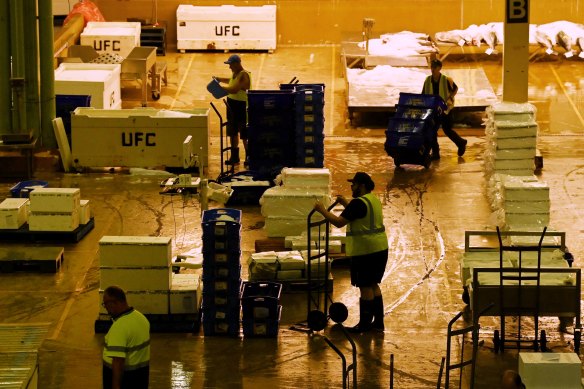
Seafood wholesalers and retailers at the Sydney Fish Market are concerned that the movement of fish from the auction floor to the shops will be inefficient in a multi-level building.Credit: Kate Geraghty
“They would build us a new building. We would get a 50-year lease. The rent would be the same as what we were paying. The fit-out would be new-for-old, like-for-like. That’s an incredible deal.”
However, the on-site tenants who owned half the shares in the Sydney Fish Market (the other half is owned by the Catchers Trust of NSW on behalf of the state’s commercial fishermen) were not content, and wanted more spent on the fit-out, Turk said.
“Some of them – not all of them – are very greedy people and they just wanted more and more and more and more,” Turk said.
When the final design was delivered with several major issues, the government had stopped listening to them, he said.
“I think the greed of the tenants combined with the inefficiencies and incompetence of Infrastructure NSW is a great mixture for a disaster.
“It’s a wonderful building – beautiful building – but it can’t function as a fish market in its current design.”

Grahame Turk, the former chairman of the Sydney Fish Market, says, “You don’t need the Taj Mahal to flog dead fish”.Credit: Dominic Lorrimer
Construction costs are now estimated at $836 million, including the price of peer reviews and independent experts who have revisited the plans among other factors, and could rise further if the tenants’ demands for change are accepted.
Chief among their concerns are the enormous west-facing windows, which they say will increase the ambient temperature on the retail level and reduce the shelf life of their product, and the multiple-level building, which they claim is incompatible with the efficient movement of goods.
Turk said the only other seafood market in the world to be built over multiple levels, the Toyosu Central Wholesale Market in Tokyo, Japan, recorded a fatality within six months of opening when a truck driver was crushed by an elevator door.
To improve efficiency and eliminate pinch points, that market has a wide internal road with ramps, lifts and hoists to move product between levels.
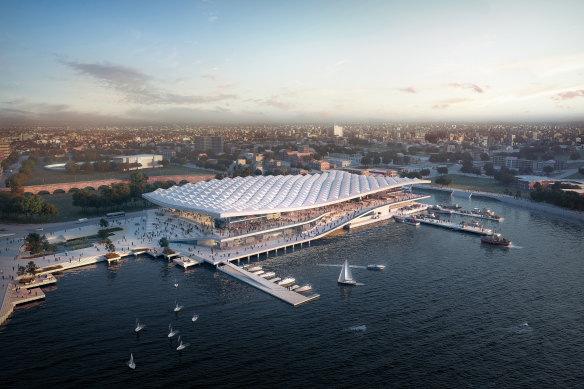
Design by 3XN and BVN for the redeveloped Sydney Fish Market.
The Pyrmont site is not big enough for an internal thoroughfare to move fish between the trucks, auction floor, wholesalers and retail stores.
Infrastructure NSW chief executive Tom Gellibrand agreed the government’s patience had been worn by years of back-and-forth over the design. The market sat on the panel that selected the design, and management knew from the start that it would be built over several levels, he said.
The tenants initially said they did not want ramps, then asked for them after the groundwork had already been laid for lifts.
They continually raised power as an issue, despite multiple consultants attesting that the supply would be more than adequate for their needs. They asked to deal with different staff at Infrastructure NSW, and every new person who dealt with them was issued the same list of demands.
“The issues don’t change, they just don’t like the answers they’re getting,” Gellibrand said.
“I think they’re really poorly advised and they’re positioning themselves to extract a better commercial deal.”
The design includes 15-metre eaves over the windows to shield them from direct sunlight. Produce can be moved between levels via 15 hoists and four goods lifts, as well as lifts, escalators and stairs for the public, who will be able to see into the operational level where the fish are auctioned as they travel from the car park to the retail level.
“All the issues they’ve raised have been assessed independently – three times in some cases – and we think it’s going to be a better building as a consequence,” Gellibrand said.
He also defended the cost of the building, which was part of a broader plan to link 15 kilometres of harbour foreshore, improve public space and stimulate tourism.
“The state’s contribution is doing more than just investing in a building. It’s this ribbon of international attraction and successive governments have contributed to that.”
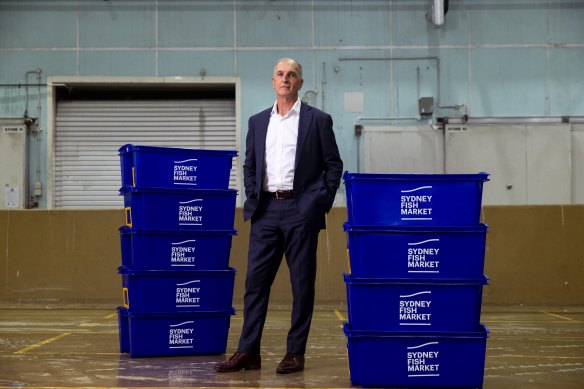
Sydney Fish Market CEO Greg Dyer says he is committed to the new site, while also floating the possibility of a new transport hub at Western Sydney Airport.Credit: Dominic Lorrimer
Sydney Fish Market chief executive Greg Dyer rejected the characterisation of the tenants as greedy, arguing they were entitled to like-for-like premises. The market needed to ensure they were operating in a safe and efficient environment, and to deliver on the government’s vision of a unique, world-class fish market, he said.
“I think most of them will come [to the new building], we’ll get them across that line,” Dyer said.
“The design of the building is something we’ve inherited and we need to make it work. We have to develop new ways of working. We’re very committed to delivering this wonderful project.”
With the new building rising rapidly, Sydney Fish Market wants the issues resolved before it is too late for any changes. It is due to meet with the government before the end of the month.